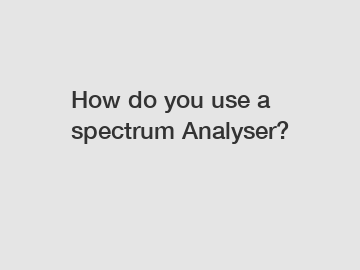Feb. 09, 2024
Measurement Instruments
In the dynamic world of wireless communications, the ability to analyze and understand radio frequency (RF) signals is invaluable. As technology continues to evolve, so does the need for professionals with expertise in utilizing advanced tools such as the spectrum analyzer. In this blog, we will delve into the intricacies of using a spectrum analyzer, exploring its various features, applications, and best practices to unlock its full potential.
Understanding the Basics:
At its core, a spectrum analyzer is a powerful instrument used to measure the amplitude and frequency distribution of RF signals. Its primary purpose is to examine the bandwidth of signals, detect interference, analyze harmonics, and assess signal quality. With advancements in technology, modern spectrum analyzers offer a rich array of features and capabilities, making them indispensable devices in many industries.

Getting Started:
1. Connecting the spectrum analyzer: Begin by connecting the relevant cables, such as the RF input and output, to the appropriate connectors on the device. Ensure proper grounding to minimize noise and interference.
2. Setting up the input parameters: Configure the center frequency and span to focus on the desired signal range. The span determines the frequency range to be displayed, while the resolution bandwidth (RBW) dictates the frequency resolution of the analyzer.
Modes of Operation:
1. Swept Mode: In this mode, the spectrum analyzer sequentially analyzes different frequencies within the designated span, providing a comprehensive display of the frequency range. It is ideal for analyzing continuous signals, identifying frequency peaks, and detecting interference signals.
2. Real-time Mode: Utilizing advanced digital signal processing techniques, real-time spectrum analyzers capture and display RF signals in real-time, offering an instantaneous view of the spectrum. This mode is particularly useful for analyzing transient events, signal modulation, and time-varying signals.
Expanding the Analytical Capabilities:
1. Spectrogram: Spectrogram analysis reveals the time and frequency characteristics of signals, offering valuable insights into intermittent interference, signal chirping, frequency-hopping, and bursty transmissions. The spectrogram display is like a waterfall, with time displayed along the horizontal axis and frequency along the vertical axis.
2. Demodulation: With the ability to demodulate various signals, spectrum analyzers can extract valuable information from modulated or encoded RF signals. Demodulation capabilities may include amplitude modulation (AM), frequency modulation (FM), phase modulation (PM), and more.
3. Harmonic and Distortion Analysis: Spectrum analyzers equipped with the harmonic measurement functionality enable thorough analysis of harmonics and spurious signals. They help identify unwanted distortion or noise injected into the signals, ensuring compliance with regulatory standards.
Applications:
1. Wireless Network Analysis: Spectrum analyzers play a crucial role in optimizing wireless networks, identifying interference sources, analyzing channel utilization, detecting dead zones, and ensuring efficient frequency allocation.
2. RF Device Characterization: Whether in product development or quality control, spectrum analyzers facilitate extensive testing of RF devices. From analyzing filter response and linearity to measuring output power and spurious emissions, they provide vital information during the design and manufacturing stages.
3. Security and Surveillance: Spectrum analyzers also find applications in security and surveillance, aiding in the detection and identification of unauthorized signals, tracking down rogue transmitters, and uncovering potential security breaches.
Best Practices:
1. Use appropriate attenuators and filters to prevent overloading the spectrum analyzer input and safeguard its sensitive components.
2. Calibrate the instrument periodically to maintain accuracy and reliability.
3. Familiarize yourself with different signal characteristics and their corresponding display patterns, enabling you to quickly identify abnormal signals or interference.
4. Optimize the use of markers and trace streaming features to capture and analyze specific signal segments efficiently.
Conclusion:
Mastering the art of spectrum analysis demands a blend of technical know-how, hands-on experience, and a deep understanding of RF signals. By leveraging the power of a spectrum analyzer and its various functionalities, professionals across diverse industries can unlock new insights, troubleshoot issues effectively, and ensure optimal performance of wireless systems. Embrace the spectrum analyzer as a steadfast sidekick, and you'll navigate the complex world of RF signals with unparalleled expertise and finesse.
Contact us to discuss your requirements of Power Quality Meters, Portable Power Quality Analyzer, 100 Mhz Signal Generator. Our experienced sales team can help you identify the options that best suit your needs.
If you are interested in sending in a Guest Blogger Submission,welcome to write for us!
All Comments ( 0 )